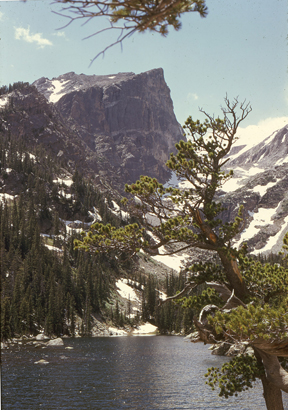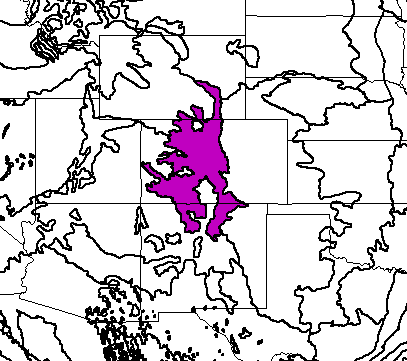
Emerald Lake, Rocky Mountain Ntl. Park, Colorado (c) 2001 Maurice J. Kaufmann
Bioimages home (click on an image to enlarge)
view
this page in its intended navigation context
Colorado Rockies Forests
(WWF
ecoregion
NA0511)

Emerald Lake, Rocky Mountain Ntl. Park,
Colorado (c) 2001
Maurice J. Kaufmann

Source of bioregions data:
Olson, D. M. and
E. Dinerstein. The Global 200: Priority ecoregions for global conservation. (PDF
file) Annals of the Missouri Botanical Garden 89:125-126.
Distinctiveness (1=highest,4=lowest): 3 (bioregionally
outstanding)
 Elevational gradients
produce dramatic vertical zonation of plants and animals, including life zones
seen in other ecoregions further north.* Sangre de
Christo Mts., Colorado. Image (c) 2004
Maurice J. Kaufmann
hires
Elevational gradients
produce dramatic vertical zonation of plants and animals, including life zones
seen in other ecoregions further north.* Sangre de
Christo Mts., Colorado. Image (c) 2004
Maurice J. Kaufmann
hires
Conservation Status (1=most endangered, 5=most
intact): 4 (relatively stable)
Logging, mining, oil and gas development, andrecreational-residential
development are threats. Downhill skiing resorts are a serious threat to
alpine and subalpine areas and contribute to fragmentation.*
 Pinus ponderosa
(ponderosa pine)
Pinus ponderosa
(ponderosa pine) Populus
tremuloides (quaking aspen)
Populus
tremuloides (quaking aspen)
Associated habitats
pinyon - juniper

along Arkansas River near Canyon City, Colorado (c) 2004
Maurice J. Kaufmann
hires
mountain park

When cool air settles in basins between mountains, treeless areas called "parks"
develop. Rt. 24 between Salida and Colorado Springs,
Colorado (c) 2004 Maurice J. Kaufmann
hires
low elevation forest


(left) Stream in Rocky Mountain Ntl. Park, Colorado. (right) Picea engelmannii (Englemann spruce) and
Pinus ponderosa
(ponderosa pine during winter in the foothills west of Ft. Collins,
Colorado. (c) 2004
Maurice J. Kaufmann
hires
hires

Wildflowers, Jemez Mountains, New Mexico.
(c) 2005 Daniel P.
Duran hires
subalpine


(left) The subalpine zone consists primarily of conifers and aspens.
(right) Fall River Road, Rocky Mountain Ntl. Park, Colorado. (c) 2004
Maurice J. Kaufmann hires
hires


continental divide, Hinsdale Co., CO (c) 2005
Daniel P. Duran
hires
hires
treeline



At high altitudes, conditions become to harsh for the survival of trees.
Treeline marks the boundary between the subalpine zone and the tundra.
(left) Treeline, Rocky Mountain Ntl. Park, Colorado. (center) Loveland
Pass, Colorado in winter. (right) Treeline, Colorado. (c) 2004
Maurice J. Kaufmann
hires
hires
hires
alpine tundra



The severe conditions and short growing season in the alpine zone limit the
species that are able to survive there. The tundra is extremely fragile
and disturbed areas remain for decades. (left) Tundra, Rocky Mountain Ntl.
Park, Colorado. (center) Stunted conifers at their altitudinal range are called
"krumholtz". Rocky Mountain Ntl. Park, Colorado. (right) Pink algae
growing in a patch of snow in the tundra. (c) 2004
Maurice J. Kaufmann

Independence Pass, Colorado.
(c) 2005 Daniel P.
Duran
hires
* Ricketts, T.H., E. Dinerstein, D.M. Olson, C.J. Loucks, et al. (1999) Terrestrial Ecoregions of North America: A Conservation Assessment. World Wildlife Fund - United States and Canada. Island Press, Washington, D.C. pp. 254-256.
Except as noted, images copyright 2002-2004 Steve Baskauf - Terms of use